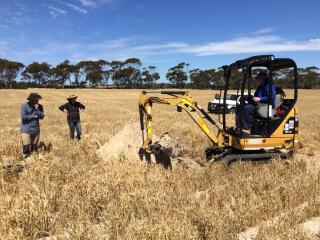Research by the Department of Primary Industries and Regional Development has found significant potential for yield improvements through re-engineering pale deep sands.
Past field trials have demonstrated that topsoil water repellence can be effectively ameliorated by spreading and mixing clay through the top 300mm with a rotary spader.
However, pale deep sands face additional subsoil constraints including compaction and low cation exchange capacity, which prevent crops from reaching their full potential.
Research investigating means of overcoming these constraints will be presented at the 2020 Grains Research and Development Corporation (GRDC) Grains Research Updates, Perth.
Department research scientist Tom Edwards said the findings could provide the key to increasing and sustaining economic benefits of pale deep sands amelioration.
The research, with co-investment from the GRDC, sought to determine if crop production could be further improved on pale deep sands which had been ameliorated.
“The aim was to improve root growth and the plants’ subsequent abilities to forage for water and nutrients later in the season,” Mr Edwards said.
“We found significant yield improvements were possible when clayed and spaded treatments were ripped to about 40cm to reduce subsoil strength and increase root penetration.
“This highlighted the need to continue to monitor soil strength and water use efficiency after amelioration as re-compaction can occur through the use of farm machinery and cultivation processes, as well as naturally as the subsoil wets and dries.”
The trial also tested the ability and benefits of introducing organic amendments and fertiliser to a 60cm soil depth using a chain trencher.
The process effectively incorporated amendments into the subsoil and improved root abundance, but benefits were only observed within the trenches that had been created and the implement failed to break out and reduce soil strength in between these.
Ripping with inclusion plates did reduce soil strength between tines and was also able to adequately incorporate chicken manure and fertiliser deep into the profile.
“Having these sources of nutrition in the subsoil improved root abundance at depth and significantly increased yield above that measured when the same amendments were left on the surface,” Mr Edwards said.
“The inclusion of the fertiliser increased yield by 750kg per hectare for the 2019 season, which was a significant improvement above ripping and applying the same rate of fertiliser to the surface.”
The 2020 GRDC Grains Research Update will be held in Perth on Monday 24 and Tuesday 25 February, while Regional Updates are scheduled in the weeks following. For details visit the GRDC Updates and events page.

Media contacts:
Jodie Thomson/Megan Broad, media liaison +61 (0)8 9368 3937
